You're the only one who thinks like YOU do, so it makes sense that these drawings will most reflect that--no matter how naive or primitive they might initially appear. If you're having trouble conjuring up ideas, maybe browse through quilt books, quilt magazines or even Pinterest. I personally find antique quilts to be some of the very best inspiration!
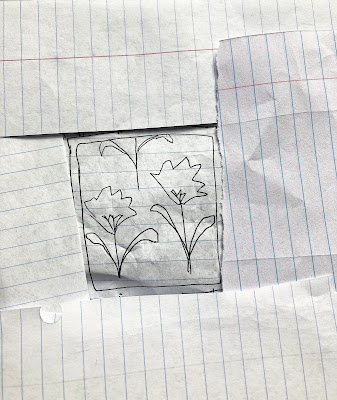 |
| This is the one that gets to shine this time |
Choose out the favorite drawing to turn into a quilt or perhaps a portion of a quilt--in this instance the center of a medallion quilt. Now it's time to somehow make these little doodle shapes become the right size and proportion needed! It's not nearly as difficult or scary as you might think.
Free Cutting Applique Shapes: At times, it's easiest to pick up a pair of scissors and just start free cutting. Use scissors and do that mind/hand thing just like you did with the doodling. Uh huh. You'll be surprised at some of the results, especially if the intended outcome is a simplistic shape. I have massacred many a stack of fabric scraps in pursuit of the perfect leaf, berry or flower! And it's easier than you think once you get the hang of it.
Free cut leaves can be cut straight from random widths/lengths of rectangular sized scraps and berries are super easy to cut from rough cut squares. No, they won't be exactly identical to other elements in the quilt, but the shape will be similar and the human touch will definitely shine through. Flowers are a bit more complicated, but with practice comes a lot of interest and personality. Don't practice on your 'good' fabric unless you have a lot of it and don't particularly care about waste. And don't be surprised when your scrap bin leaves end up finding a place in your quilt after all. They can be fairly charming at times!
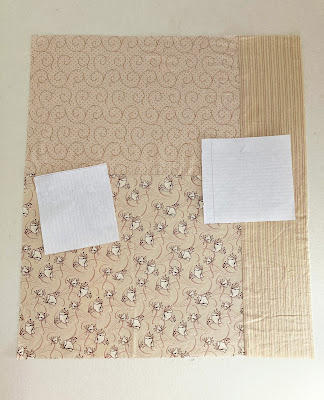 |
| Trying to figure out proportion |
Making Paper Applique Templates: The other method that I use quite a lot is to cut paper templates first--before cutting and/or wasting good fabrics. Can you tell that my frugal side takes over sometimes? Referring to your doodle picture, {I'm using notebook paper primarily as it's cheap and the lines can be helpful}, draw each individual shape over and over until you get something decent. Surprisingly, this CAN happen as you're only copying at this point. I promise it gets easier and easier with practice, and eventually you'll get to the point of only having to draw a shape one to three times before getting it right!
If it's a tricky shape {or a larger size} and you're worried about proper proportion, here's a good tip. Cut out paper squares, rectangles etc. in the approximate, intended size and place them onto the made background fabric. Step back from your design wall or floor and take a look. Keep going until you think the proportions are within the desired range, then try drawing the wanted {planned} shape onto those same papers. You're still
copying a pre-determined shape, but now you have a box to keep it inside of. Sometimes that feels helpful and other times can be annoying. You'll want to take the papers off of the background of course, before drawing. For very large sizes, I've used everything from freezer paper, butcher paper, light weight cardboard and even the back of gridded Christmas paper!
 |
| Drawing, cutting and more drawing |
When there is finally a shape that seems satisfactory, go ahead and cut it out in paper shape. Don't worry about seam allowances at this point! Also, remember that this shape doesn't have to be
identical to the one in your doodle. In repeated drawings, your hand/mind connection will make constant little adjustments and revisions to make it ever more pleasing to your discriminating eye.
Place all the shapes onto the background fabric in as close to the right spot as possible. Move shapes side to side and up and down until everything looks fine. Be sure to step back and look at it with some distance too. Sometimes there will be a small adjustment needed that's not immediately obvious when looking at close range.
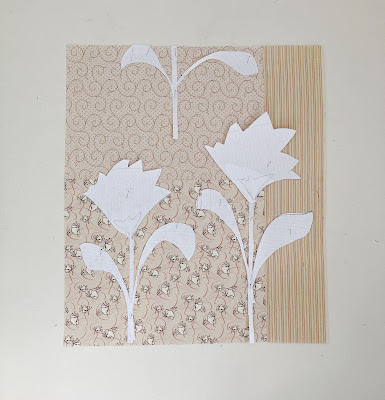 |
| The paper template audition |
If certain shapes are bothering you {for whatever reason} then it might be necessary to make small tweaks to them. Use your scissors judiciously at this point. Sometimes it's better to keep a shape that
almost works than permanently ruin any hope of ever achieving it again! If something needs to be made a little bit larger or smaller, then washi tape might be your friend. Extra paper can be added behind to stretch a design, careful folds can be introduced, another triangle can be taped into just the right place.... Play until you can relax and smile or take a break and come back later with fresh eyes.
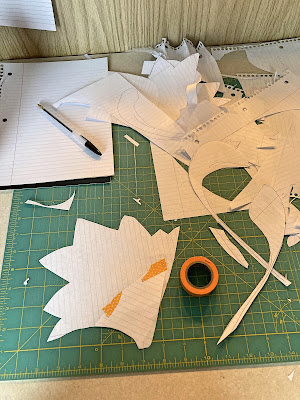 |
| Making adjustments to paper templates |
Choosing fabric for applique: Probably want to get your fabric choices sorted first. For a centerpiece in a medallion style quilt, look for slightly bolder, darker, brighter or perhaps lighter fabric blendings than might be used in the rest of the quilt. Doesn't have to be more than a degree or two, but you want these applique elements to 'pop'.
You want them to matter. Using all medium value prints just won't pull off enough of a look-at-me vibe here in this spot! Look through your fabric stack and deliberately use value changes to your advantage. Might be a good idea to dig deeper in the stash if there seems to be any lack.
Occasionally a fabric will seem to be way too obnoxious to be added into a marinating stack of fabric, but will work really, really well here. I often lay fabric options right over the top of those paper shapes still resting against the background fabric. You can kind of scrunch the fabrics around or fold them into smaller pieces to get an idea of how they might look in the proportionate size.
I much prefer the scrappy look for applique. Lots of different fabric use for leaves and flowers especially as I love the subtlety of 'similar but different' and the opportunity for highlighting minor value changes. It can effortlessly add lots of spark, energy and soul to a quilt by mixing things up. In this case I used three different fabrics for the stems. If the quilt seems to need specific areas of calm, then try a single-fabric use for all the stems or whichever element needs to be more in the background.
The method for which you intend to apply your applique might determine the fabric you choose for applique too. Many people will recommend using Batik fabrics as they are very resistant to fraying. Ughh. They are horrible to hand sew. Don't use painted on fabrics either unless you are applying your applique by machine. Soft, supple fabrics, upcycled fabrics, wovens--all of these will feel and handle ridiculously better if sewing by hand, and the time spent stitching will be cut in half.
In the picture below, you can see my first choice fabrics cut out in the designated applique shapes and sort of thrown onto the background fabric. All of these are cut out with a seam allowance included, so of course after sewing, they will shrink slightly in appearance.
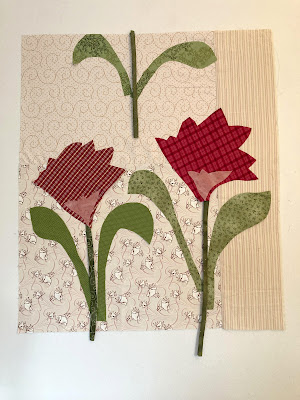 |
| Getting the shapes cut out into fabric |
Three common methods to transfer paper shapes onto fabric:
Draw your paper shapes directly onto the backside of the chosen fabric {ball point pen is perfectly fine} and cut out, adding a scant quarter inch extra for seam allowance. Remember to use the reverse side of the template when marking the template lines so the applique shape will present the right way!
Another common way to transfer the template is to draw the paper cut-out shape onto the top of freezer paper {dull side}. Cut freezer paper out exactly at the marked lines and then iron over the top of the appropriate fabric. Don't slide the iron back and forth, but try to cover the shape with the iron and hold still for a moment. Pick up and move the iron again if needed. When the freezer paper is sticking to the fabric, then you can cut out your fabric shapes, once again adding the scant quarter inch extra for seam allowance. Gently peal off the freezer paper and use over and over again, if necessary.
The third way to transfer a paper template, is to draw the paper shapes directly onto what's called 'template plastic ' sold in sheets at JoAnn Fabrics etc. Carefully cut out your new, more long-lasting templates and proceed the same as with the paper templates.
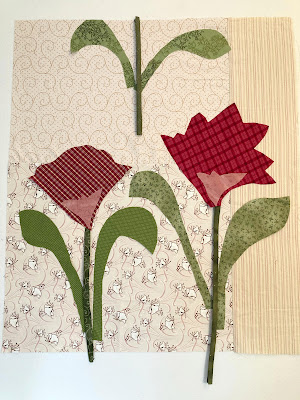 |
| Option of smoothing the look of applique |
You can simplify applique shapes: Occasionally you will find that an applique template is just the right size and proportion, but maybe a little too complicated for your skill level. Or maybe it's going too take up time spent sewing that you're not wanting to commit to at the moment. Perhaps you want a naive, prim look. It's easy enough to smooth out the sharp, trickier edges with a pair of scissors, either directly on the paper template or the cut-out fabric shape itself. This goes for applique templates you've borrowed from other patterns, or even ones you've made yourself. There is no shame in simplifying the look of any applique design. In fact, altering templates in this way can serve to heighten a cozy vibe or quickly personalize a look.
Fine tuning the applique representation before sewing: In the picture below, I still haven't positioned or pinned things in the exact spot for sewing. Before doing that, I often take a deeper look. Is it doing what I want or need it to do? Matching up to what I had envisioned in my head? Here, I was questioning the look of that first flower stem fabric, which I still didn't like. You probably didn't notice, but this is my 2nd choice fabric. Sometimes you have to actually see it cut out in the true size, then place it in the intended spot, before you say 'meh!. That won't work either.'*sigh In this case, I went back to the first choice and called it good.
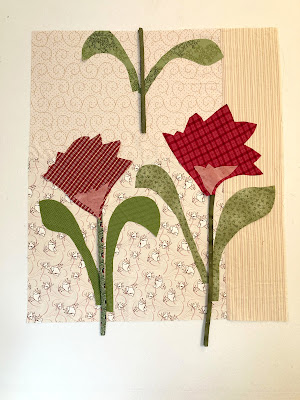 |
| Looking at a stem in different fabric |
Making Simple Straight Grain Stems: My basic rule of thumb for making straight grain stems is to cut out the intended width x 2, plus a quarter inch extra. These particular stems ended up being cut out at 1 1/4" x whatever length was needed. Each long, rectangular fabric unit is then folded in half with wrong sides together. Sew those wrong sides together with a
very scant seam {move your needle over if possible}. Next, iron the thin tubes of fabric flat, making sure the seam ends up in the middle of the back side.
You can skip this step and cut out stems with seam allowance only {like how you sew flower shapes etc.}. The trouble is, inevitably, long straight applique pieces want to ripple and warple even with good pinning. Sewing a tube of fabric helps stabilize things and give off a sharper appearance. I will endeavor to explain a simple method for making bias stems at a later date.
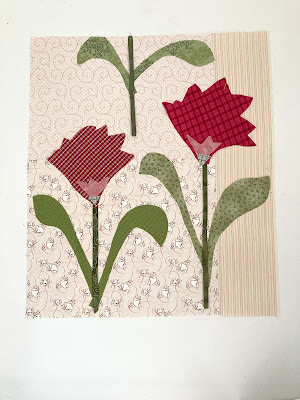 |
| Figuring out how add another color |
Letting your intuition do its thing: Improv. works best when you pay attention to the little niggle of feeling that says '
You know, this could probably look a lot better'. It's not usually some majorly complicated thing. Many times, in fact, it's a relatively easy fix that involves
more of something or
less of something. Perhaps one of the elements simply wants for a slight value change or hmmm.. a completely different color or print of fabric used altogether? Tiny adjustments can have a big impact. Play a little but don't ever think you have to start completely from scratch. If you're willing to cut up a little bit of fabric, do a little 'trial and error', you'll no doubt find the answer.
As to my centerpiece, a bit of contemplation helped me understand that the overall look was clearly too bland. It needed a spark to lift the look. Rifling through my fabric stack didn't conjure up anything exciting, and so back to the stash totes I went for inspiration. Finally, I pulled out this much lighter, kind of blue-ish green fabric that didn't feel specially complementary to the original fabric pull. Funny how it seems to work fabulously in this setting though! In the picture above, you can see where I cut out little triangles and tried placing them at the base of each flower. Hmmm... that's better, but still not quite right. What else could I do?
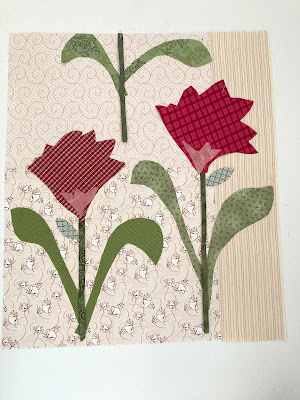 |
| Finally getting the look I want |
I left the composition up on the wall and ignored it for the evening. Much, much later in the night, the thought casually popped into my head that many natural flowers have little, barely-there leaves up near the base of a flower. Replicating that look could hopefully {fingers crossed} make a little, much needed sort of magic start happening. Just a miniscule addition and now the whole thing resonates incredibly better.
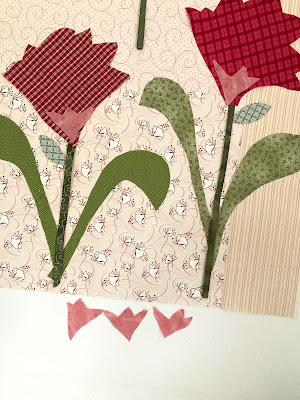 |
| Playing with minute changes to an applique element |
Another thing you might have noticed that I tinkered with, was the pink motif at the base of the flowers. I kept cutting out slightly different, but similar shapes until finding the ones that had the just the right energy. One of the shapes was basically the same size/shape, only in reverse! Such a simple thing, but it helps to keep playing until a quilt says '
enough'! And there is definitely a time to stop and move on. No sense in driving yourself crazy!
When everything looks just right color-wise and design-wise, then it's time to position the applique
exactly where it needs sewing. Pin in place and stitch the bottom layer first, then the next layer, and so on till it's all finished.
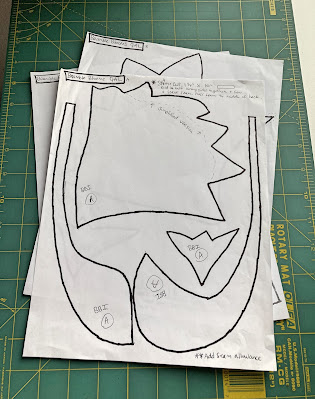 |
| BBI templates all ready to go |
Feel free to apply the applique to your quilt in any manner you like, be it hand sewing or machine sewing. I use a form of needle-turn applique as I love the slight imperfections that seem to organically happen, but you do you. Lots of good tutorials and options floating around on the Internet these days. Also, I have the templates converted to pdf's for anyone who doesn't have the time or energies to dive into Freehand Applique right at the moment. Please request these in my email at audkateaster at gmail dot com, NOT in the comment section. This QAL is generally free to all, but I respectfully ask that you consider dropping a couple dollars in the tip jar if you are specifically wanting the pdf's. Hopefully this will be set up by next week if my un-techy self can figure things out!
Yes, it's a rather lengthy post about the process of Improv. when it comes to applique play. It's kind of my passion! Such a wonderful way to add lots of personalization and the also the charming benefits of the human touch to our makes. You did want to know how to do things the 'Quilty Folk' way, right?
Next up {after some normal quilty posts}, will be another prompt in the QAL. Which incidentally, is the first border to our medallion design. For those just joining up, please send an email when you have posted your start to this QAL. That email is the only way I will add you to the link list of participants. If you're not especially interested in being included in the link list, but want to follow along with the QAL regardless, that's perfectly fine too. I get it! Stepping outside of our comfort zone and sharing our work at the same time can probably feel somewhat brutal. Ughh Don't know how many times I've winced when pressing the 'publish' button. As per usual, sometimes I'll need a couple days to respond.
**There are still comments on posts where I am unable to link back to the person or specific blog. Sharon from Pflugerville and Chel Smith from Texas--Sorry, I don't have a way to contact either of you. Please email if you want to join the link list. Sorry, don't have a clue how to make the commenting easier for everyone without opening the blog up to mountains of spam.














Ohmygosh--you are really tempting me to try this...I am not usually a QAL person--but your tutorial here is fantastic--how wonderful to share your methods with us all..soooo tempted--hugs, Julierose
ReplyDeleteWhat a thorough post. Thank you so much. And there looks like a raining week ahead so a great time to play with fabric.
ReplyDeleteI've been waiting for the next post and it delivers! My first thought is to just use the templates you've drawn. I like the look. But that's not what this is about, is it? So today while I do some mindless quarter square construction (needed for another quilt, of course), I'll think on what kind of flowers I want and maybe start doodling tonight when the hubby is watching some atrocious television but wants me to "spend time with him"... I'm excited to start - thanks for the inspiration and instruction!
ReplyDeleteyes for applique it is always nice to use a variety of prints and solids - using more than one always gives more interest!
ReplyDelete
ReplyDeleteAfter dithering over centerpiece fabrics for a week, I decided to wait until the applique post to decide which set to use. Today the post appears and now I want to start two Quilt 1s in entirely different colorways. We'll see how long that idea lasts...
Appreciate all the work you're putting into this QAL. I don't have a blog but will upload my work to Instagram.
Brilliant Audrey!! I'm looking forward to developing my applique design this coming week. I do have three designs in mind, must decide which one to go with! Huge thank you for all the information and inspiration in the post, without all you have written I wouldn't be anywhere near as confident.
ReplyDeleteQuiltdivajulie - like Katie, I was tempted to simply use your PDF but I am going to try my own design instead (in the spirit of pushing myself). I may still use some of your previous work as inspiration though :-)
ReplyDeleteI'm like the little engine, I think I can...do this. I will be giving it a try today though I already know I do not have your eye for fabric selection. And many many thanks for this wonderful detailed post.!
ReplyDeleteFirst I do good to finish one quilt in a sew along😄 but 3 oh my! LoL will this be one at a time or a little on all 3 along the way or is that part of keeping the curiosity stirred up? this quilt along certainly has mine stirred up 😄 I've never added applicade to a quilt but I know what it means unlike googling medallion layout 🤣🤣
ReplyDeleteHi, This appeals to me, but we are on vacation right now, far from my fabrics and not a sewing machine in sight. Can I start late? It will be after Nov. 20. Email is epm dot mail dot 444 dot at gmail dot com In any case I will be following and enjoying. Love improv!
ReplyDeleteWell I'm back🤣 I just emailed you to sign me up🤣
ReplyDeleteWow Audrey! So many people are joining in on your QAL! It is going to be so fun watching everyone's progress and seeing their designs. I am off to design a floral applique!
ReplyDeleteI'm very happily spending creative time with Bramble Blooms. I've made it as far as a general shape/positioning layout over at my Schottische blog. Thanks, Audrey!
ReplyDeleteGreat tutorial, thank you. I'll have fun settling into this. It reminds me crazy quilting.
ReplyDeleteSuch an informative post Audrey! I am lurking in the background, wanting to participate, but feeling not creative enough to actually join in.
ReplyDeleteHave joined BB1, will make 1 quilt only as I do not need more quilts but want some sewing, anyway halfway appliqueing flowers and basket, nicolettemathee@gmail.com
ReplyDeleteHi Audrey! I'm so glad everyone is well at your house! Delighted to read through the new prompt and can't wait to get busy with it after the weekend. Happy new year!
ReplyDelete